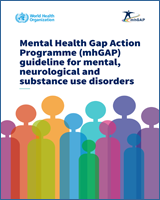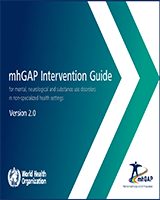People with depression experience a range of symptoms including persistent depressed mood or loss of interest and pleasure for at least 2 weeks.
People with depression as described in this module have considerable difficulty with daily functioning in personal, family, social, educational, occupational or other areas.
Many people with depression also suffer from anxiety symptoms and medically unexplained somatic symptoms.
Depression commonly occurs alongside other MNS conditions as well as physical conditions.
The management of symptoms not fully meeting the criteria for depression is covered within the module on Other Significant Mental Health Complaints. Go to » OTH.
DEP 2. Management

PSYCHOSOCIAL INTERVENTIONS
2.1. Psychoeducation: key messages to the person and the carers
- »
Depression is a very common condition that can happen to anybody.
- »
The occurrence of depression does not mean that the person is weak or lazy.
- »
Negative attitudes of others (e.g. “You should be stronger”, “Pull yourself together”) may be because depression is not a visible condition, unlike a fracture or a wound. There is also the misconception that people with depression can easily control their symptoms by sheer willpower.
- »
People with depression tend to have unrealistically negative opinions about themselves, their life and their future. Their current situation may be very difficult, but depression can cause unjustified thoughts of hopelessness and worthlessness. These views are likely to improve once the depression improves.
- »
Thoughts of self-harm or suicide are common. If they notice these thoughts, they should not act on them, but should tell a trusted person and come back for help immediately.
2.2. Reduce stress and strengthen social support
- »
Assess for and try to reduce stressors. (Go to » ECP)
- »
Reactivate the person's previous social network. Identify prior social activities that, if started again, may potentially provide direct or indirect psychosocial support, e.g. family gatherings, visiting neighbours, and community activities.
2.3. Promote functioning in daily activities and community life
- »
Even if it is difficult, encourage the person to try to do as many of the following as possible:
- –
Try to start again (or continue) activities that were previously pleasurable.
- –
Try to maintain regular sleeping and waking times.
- –
Try to be as physically active as possible.
- –
Try to eat regularly despite changes in appetite.
- –
Try to spend time with trusted friends and family.
- –
Try to participate in community and other social activities as much as possible.
- »
Explain to the person and carer that these activities can all help improve mood.
2.4. Brief psychological treatments for depression
This guide does not provide specific protocols to implement brief psychological interventions. WHO, among other agencies, has developed manuals that describe their use for depression. An example is, Problem Management Plus, (http://www.who.int/mental_health/emergencies/problem_management_plus/en/), which describes the use of behavioural activation, relaxation training, problem solving treatment and strengthening social supports. Moreover, the manual Group Interpersonal Therapy (IPT) for Depression describes group treatment of depression (http://www.who.int/mental_health/mhgap/interpersonal_therapy/en). Thinking Healthy, (http://www.who.int/mental_health/maternal-child/thinking_healthy/en), describes the use of cognitive-behavioural therapy for perinatal depression.
PHARMACOLOGICAL INTERVENTIONS
2.5. Consider antidepressants
- »
Discuss with the person and decide together whether to prescribe antidepressants. Explain that:
- –
Antidepressants are not addictive.
- –
It is very important to take the medication every day as prescribed.
- –
Some side effects may be experienced within the first few days but they usually resolve.
- –
It usually takes several weeks before improvements in mood, interest or energy is noticed.
- »
Consider the person's age, concurrent medical conditions, and drug side-effect profile.
- »
Start with only one medication at the lowest starting dose.
- »
Antidepressant medications usually need to be continued for at least 9-12 months after the resolution of symptoms..
- »
Medications should never be stopped just because the person experiences some improvement. Educate the person on the recommended timeframe to take medications.
CAUTION
- »
If the person develops a manic episode, stop the antidepressant immediately; it may trigger a manic episode in untreated bipolar disorder.
- »
Do not combine with other antidepressants, as this may cause serotonin syndrome.
- »
Antidepressants may increase suicidal ideation, especially in adolescents and young adults.
Antidepressants in special populations
ADOLESCENTS 12 YEARS OF AGE OR OLDER
- »
If symptoms persist or worsen despite psychosocial interventions, consider fluoxetine (but no other selective serotonin reuptake inhibitor (SSRI) or tricyclic antidepressant (TCA)).
- »
If fluoxetine is prescribed, ask the adolescent to return weekly, for the first 4 weeks, to monitor thoughts or plans of suicide.
WOMEN WHO ARE PREGNANT OR BREASTFEEDING
- »
Avoid antidepressants, if possible.
- »
Consider antidepressants at the lowest effective dose if there is no response to psychosocial interventions.
- »
If the woman is breastfeeding, avoid long acting antidepressant medication such as fluoxetine.
- »
Consult a specialist if available.
OLDER ADULTS
- »
Avoid amitriptyline if possible.
PEOPLE WITH CARDIOVASCULAR DISEASE
- »
Do NOT prescribe amitriptyline.
ADULTS WITH THOUGHTS OR PLANS OF SUICIDE
- »
SSRIs are the first choice. Overdose of TCAs such as amitriptyline may be fatal and therefore should be avoided in this group.
- »
If there is an imminent risk of self-harm or suicide (Go to » SUI), give a limited supply of antidepressants (e.g. one week supply at a time).
- »
Ask the person's carers to keep and monitor medications and to follow-up frequently to prevent medication overdose.
DEP 3. Follow-up

TABLE 1Antidepressants
View in own window
| MEDICATION | DOSING | SIDE EFFECTS | CONTRAINDICATIONS / CAUTIONS |
|---|
AMITRIPTYLINE
(a tricyclic antidepressant (TCA)) | Start 25 mg at bedtime.
Increase by 25-50 mg per week to 100-150 mg daily (maximum 300 mg).
Note: Minimum effective dose in adults is 75 mg. Sedation may be seen at lower doses.
Elderly/Medically Ill: Start 25 mg at bedtime to 50-75 mg daily (maximum 100 mg).
Children/Adolescents: Do not use. | Common: Sedation, orthostatic hypotension (risk of fall), blurred vision, difficulty urinating, nausea, weight gain, sexual dysfunction.
Serious: ECG changes (e.g. QTc prolongation), cardiac arrhythmia, increased risk of seizure. | Avoid in persons with cardiac disease, history of seizure, hyperthyroidism, urinary retention, or narrow angle-closure glaucoma, and bipolar disorder (can trigger mania in people with untreated bipolar disorder).
Overdose can lead to seizures, cardiac arrhythmias, hypotension, coma, or death.
Levels of amitriptyline may be increased by anti-malarials including quinine. |
FLUOXETINE
(a selective serotonin reuptake inhibitor (SSRI)) | Start 10 mg daily for one week then 20 mg daily. If no response in 6 weeks, increase to 40 mg (maximum 80 mg).
Elderly/medically ill: preferred choice. Start 10 mg daily, then increase to 20 mg (maximum 40 mg).
Adolescents
Start 10 mg daily. Increase to 20 mg daily if no response in 6 weeks (maximum 40 mg). | Common: Sedation, insomnia, headache, dizziness, gastrointestinal disturbances, changes in appetite, and sexual dysfunction.
Serious: bleeding abnormalities in those who use aspirin or other non-steroidal anti-inflammatory drugs, low sodium levels. | Caution in persons with history of seizure.
Drug-Drug interactions: Avoid combination with warfarin (may increase bleeding risk). May increase levels of TCAs, antipsychotics, and beta-blockers.
Caution in combination with tamoxifen, codeine, and tramadol (reduces the effect of these drugs). |



